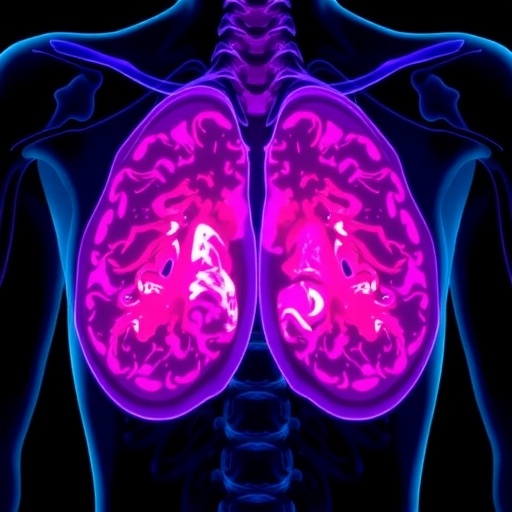In a groundbreaking study published in Cell Reports Medicine, scientists at the UCLA Health Jonsson Comprehensive Cancer Center have elucidated a pivotal mechanism by which leukemia cells orchestrate their relentless growth and survival. Central to this discovery is the protein IGF2BP3, a previously underappreciated molecular player that integrates two fundamental cancer cell processes: metabolic reprogramming and RNA regulation. By linking these pathways, IGF2BP3 emerges as a crucial “master switch” that drives the aggressive proliferation characteristic of leukemia.
Cancer cells notoriously adapt their metabolism to meet the high energy and biosynthesis demands of uncontrolled growth. One hallmark of this adaptation is the preferential use of glycolysis, a quick but inefficient sugar breakdown pathway that generates metabolic intermediates essential for cell division. The UCLA team’s research uniquely identifies IGF2BP3 as a key modulator that not only modulates RNA but drastically shifts leukemia cells toward this glycolytic metabolism, highlighting a dual role that redefines conventional views of cellular regulation in cancer biology.
Professor Dinesh Rao, leading the study at UCLA’s David Geffen School of Medicine, emphasizes the surprising breadth of IGF2BP3’s influence, stating that its contribution to metabolic remodeling was unexpected and highly significant. This novel insight uncovers an intricate interplay between gene expression control at the RNA level and energy metabolism, processes long assumed to operate separately in cancer cells. The discovery implies that impeding IGF2BP3 could simultaneously halt the metabolic fueling and protein synthesis machinery that leukemia cells exploit to aggressively proliferate.
IGF2BP3 belongs to a family of RNA-binding proteins typically active only in early human development, after which their expression dramatically decreases. However, in various malignancies such as leukemia, brain tumors, sarcomas, and breast cancers, this protein mysteriously reactivates, driving oncogenic processes. The UCLA group’s prior work demonstrated that IGF2BP3 is indispensable for a highly aggressive subtype of pediatric acute lymphoblastic leukemia, with knockout mouse models resistant to leukemia development without evident health defects. These findings suggested IGF2BP3’s unique role in cancer, spurring further exploration of its impact on cellular energetics.
To interrogate IGF2BP3’s metabolic role, the researchers utilized the sophisticated Seahorse assay technology. This method measures oxygen consumption and extracellular acidification rates, effectively placing cells on a metabolic treadmill to analyze how they utilize energy. Remarkably, leukemia cells deprived of IGF2BP3 showed a profound reduction in glycolysis, indicating that the protein favors rapid sugar catabolism despite its inefficiency in total ATP generation. This metabolic shift ensures a supply of anabolic precursors critical for rapid cell growth, illustrating how IGF2BP3 orchestrates adaptive metabolism tailored to leukemia cells’ survival.
Further metabolic tracing revealed that without IGF2BP3, levels of S-adenosyl methionine (SAM), a universal methyl donor for RNA modifications, plummeted. As RNA methylation is vital for post-transcriptional gene regulation and proper protein synthesis, this finding highlights an elegant feedback loop where IGF2BP3-dependent metabolism affects RNA regulation through epigenetic-like chemical tagging. The diminished RNA methylation marks in IGF2BP3-deficient cells elucidate a previously unrecognized axis linking metabolism directly to RNA function, reshaping the conceptual framework of cancer cell biology.
To validate these molecular insights in vivo, the team engineered mice lacking the IGF2BP3 gene and subsequently introduced the human IGF2BP3 gene. This reintroduction restored the disrupted metabolic and RNA regulatory processes, unequivocally confirming IGF2BP3’s central role in driving the pathological state. This animal model experiment underscores the therapeutic potential of targeting IGF2BP3, as its absence impedes leukemia development while sparing healthy tissue function, making it an attractive candidate for anti-cancer drug development.
Postdoctoral scholar Dr. Gunjan Sharma, a pivotal member of the research team, described the multistep cascade initiated by IGF2BP3 as a “chain reaction.” The protein’s absence reverberated through cellular systems, not only attenuating energy utilization but also altering the chemical and epigenetic landscape governing RNA. This discovery provides a mechanistic explanation for how leukemia cells co-opt metabolic and RNA regulatory networks to maintain their malignant state, offering a holistic target instead of isolated pathways that often lead to drug resistance.
The study’s findings signify that the glycolytic pathway favored by leukemia cells via IGF2BP3 is chosen not for energy efficiency but for its biosynthetic advantage. The swift generation of metabolic intermediates supplies essential building blocks like nucleotides and amino acids, while SAM-driven RNA modifications ensure robust translation of oncogenic proteins. This metabolic rewiring crafts a cancer-specific survival niche, dramatically differentiating malignant cells from their normal counterparts and revealing vulnerabilities that could be exploited therapeutically.
IGF2BP3 thus functions as a molecular architect, simultaneously reshaping energy metabolism and RNA modification machineries to produce an optimal environment for cancer cell endurance and expansion. By coordinating these complex networks, the protein secures leukemia cells’ dominance in hostile conditions that would otherwise suppress normal cell proliferation. This dual regulatory role distinguishes IGF2BP3 from traditional cancer targets that typically affect singular pathways.
While this research filtered through the lens of leukemia, the implications are far-reaching. Similar metabolic and RNA regulatory strategies may be operational across diverse cancer types, including solid tumors like breast cancer and brain cancers where IGF2BP3 is aberrantly expressed. Therefore, insights gained here could inspire broad-spectrum therapies targeting metabolic and post-transcriptional regulatory hubs critical to malignant growth, potentially revolutionizing oncology treatment paradigms.
Moreover, the researchers propose that heightened expression of IGF2BP3 may serve as a diagnostic biomarker, pinpointing cancers that depend on these integrated pathways and identifying patients likely to benefit from therapies aimed at disrupting IGF2BP3’s function or the metabolic networks it controls. This stratification could enhance precision medicine efforts and optimize clinical outcomes in cancer care.
Currently, Rao’s laboratory is advancing small-molecule inhibitors designed to block IGF2BP3 activity. The most effective therapeutic strategies may combine these molecular inhibitors with drugs that directly interfere with cancer metabolism, creating a one-two punch that starves cancer cells energetically and impairs their RNA regulatory machinery. Such combination therapies hold promise for overcoming resistance mechanisms and achieving durable remissions in patients with aggressive leukemia and possibly other IGF2BP3-driven tumors.
The multidisciplinary team contributing to this study spans expertise in molecular biology, metabolism, and translational medicine, including researchers from UCLA and the University of California, Santa Cruz. Supported by grants from the National Institutes of Health and the California Institute for Regenerative Medicine, this collaboration underscores the importance of integrated scientific approaches in unraveling complex cancer biology and moving toward innovative therapies that could save countless lives.
Subject of Research:
Leukemia cell metabolism and RNA regulation linked by IGF2BP3 protein
Article Title:
IGF2BP3: A Master Regulator Linking Metabolic Reprogramming and RNA Modification in Leukemia
News Publication Date:
2025
Web References:
http://dx.doi.org/10.1016/j.celrep.2025.116330
Keywords:
Leukemia, RNA, Metabolism, Cancer, Blood cancer, Cancer cells, Cancer research, Oncology




